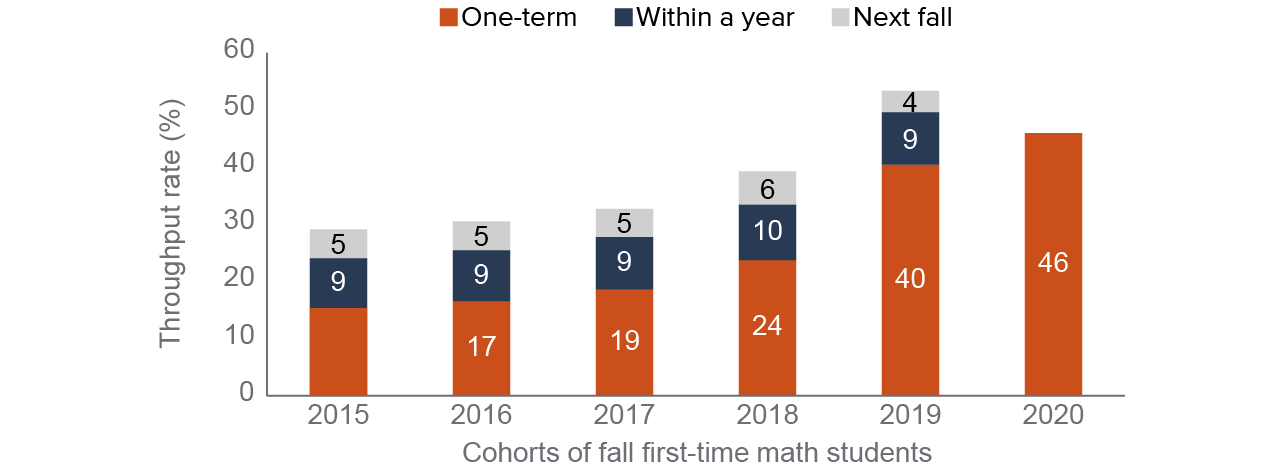For years, far too many California community college students were required to take developmental courses that did not count for transfer, keeping them from reaching their academic goals. A landmark law (AB 705) has dramatically expanded access to the math and English courses students need to transfer to a four-year college.
- As of fall 2019, almost all students now start in transfer-level English. Enrollment in transfer-level math skyrocketed, but 20% still start in courses below transfer-level.
- In fall 2020, 46% of first-time math students completed transfer-level math in one term, compared to 24% in fall 2018. Even so, only about half complete a transfer-level math course within a year.
- In all racial/ethnic groups, more students are completing transfer-level math. Equity gaps in access have narrowed, but Latino and Black students still see lower completion rates than their peers.
- The pandemic did not slow implementation of these reform efforts. Systemwide enrollment fell, but access remained far higher than before AB 705’s implementation.
In 2018, California enacted Assembly Bill 705, a law requiring colleges to maximize the likelihood a student will enter and complete transfer-level math or English within a year. Colleges must now use measures such as high school transcripts and GPA to place students in math and English courses instead of assessment tests. Furthermore, colleges can only require a student to enroll in remedial math or English if they can prove a student is highly unlikely to succeed at transfer-level.
Essentially, AB 705, which community colleges first began implementing in fall 2019, intends to shrink the number of students placed in remedial English and math courses. These courses had been a major barrier to students seeking to transfer. The reform also aimed to address racial and ethnic gaps in course access and completion.
How did course placement affect students before AB 705?
In the past, community colleges relied on assessment tests to place new students into math and English. About 80% of students started in remedial or below transfer-level courses. This approach put students into course sequences that added time and cost to their education—and most students who landed in these sequences eventually left college without transferring or completing a degree.
How did AB 705 benefit students who started in transfer-level math?
After implementation, the number of students who enrolled directly into introductory, transfer-level math tripled systemwide—from 22% in 2015 to 80% in 2019. The rate of students who passed their introductory course shot up from 15% to 46%.
After AB 705, about half of first-time math students passed transfer-level math course within a year

SOURCE: Authors’ calculations using MIS data.
NOTE: Only the first term is available for the fall 2020 cohort.
But at one in five community colleges, a third or more of students are still enrolling in courses that don’t count for transfer—on average, at colleges with a higher share of Black and Latino students taking math for the first time. When access to transfer-level is restricted or discouraged, Black and Latino students are more likely to end up in below transfer-level courses. And students in those courses are especially unlikely to then complete a transfer-level math course.
What has AB 705 meant for racial equity gaps?
With increased access, thousands more Latino and Black students have completed transfer-level math. Completion rates for Latino students increased dramatically, from 9% in fall 2015 to 39% in fall 2020; for Black students the rate rose from 7% to 31%. Yet despite these significant gains, Latino and Black students remain underrepresented in successful completion of transfer-level math, with lower rates than their Asian American and white peers.
What additional strategies can help more community college students succeed?
Enroll students who intend to transfer into transfer-level courses by default. Direct enrollment into transfer-level courses better supports student success in math than enrollment into other courses. To help students enroll in the appropriate math pathway (e.g., statistics or traditional math), counselors, advisors, and faculty should work together.
Adapt flexible strategies from the pandemic to face-to-face environments. Amid the pandemic, colleges expanded online student supports like tutoring and mental health services. Faculty used more video lectures, which allowed students to learn at their own pace. As colleges move into hybrid environments, they should incorporate these and other flexibilities.
Prioritize addressing equity gaps, especially in math. By transforming teaching strategies and materials so coursework is engaging and accessible for all students, instructors can help to create equitable classrooms. Professional development can support faculty members and advisors in adjusting to changes under AB 705.
Use the longitudinal student database to assess student supports. The state is developing a data system that could be used to examine how best to support student success. Colleges that identify how to connect students with social services—including food programs—and supports like tutoring and financial aid, can then invest in the most effective strategies to improve student outcomes.
Topics
Access Equity Higher Education K–12 EducationLearn More

A New Era of Student Access at California’s Community Colleges

Community College English in California’s New Era of Student Access

Ensuring All Students Benefit from Landmark Community College Reform

Mapping Equitable Access to Math at California’s Community Colleges

Video: Community College Math in California’s New Era of Student Access

What Happens When Colleges Broaden Access to Transfer-Level Courses? Evidence from California’s Community Colleges


